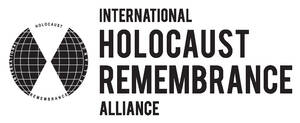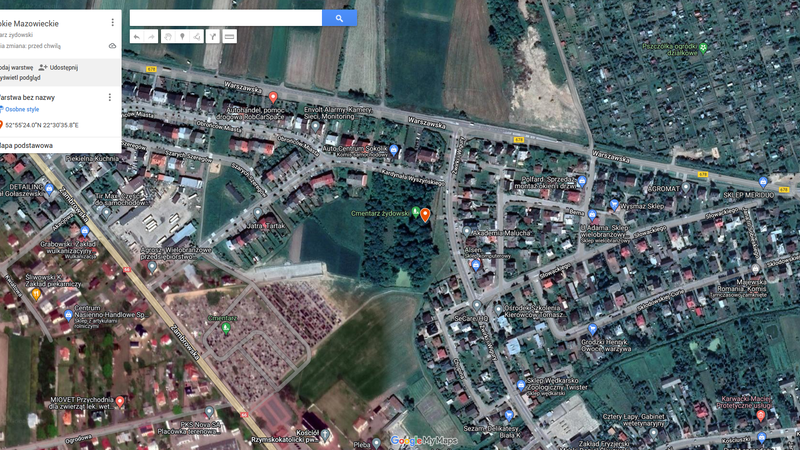Wysokie Mazowieckie
Borough of Wysokie Mazowieckie , Wysokomazowiecki District, Podlaskie VoivodshipType of place
Under the wall of the Jewish cemeteryInformation about the crime
The Register of Killing Sites and Crimes of the former łomżyńskie voivodeship records the following events in Wysokie Mazowieckie:
“- 10 September 1939 – a man (a Jew) was burnt in his own house
– June 1941 – a Jew named Rutkowski (first name unknown) was shot in the street
– 1942 – military police officers shot 4 Jewish people. The bodies of the victims were buried in a field near Dworska Street.
– August 1943 – during a roundup, a group of about 30 Jews were caught in the early morning hours. They were shot in the Jewish cemetery near Krzywa Street. The bodies of the victims were buried in the Jewish cemetery”.
In the winter of 2022, we went to Wysokie in connection with correspondence that the Rabbinical Commission once had with a Jewish descendant from Wysokie concerning the mass grave of members of his family murdered in 1943. According to the information he gathered, at least 14 people, including two aunts of his grandmother and her children, were murdered in April 1943 on a day called The Great Thursday by the locals.
The memory book of Wysokie contains an account of survivor Abraham Berl Sokol, who remembers the murder of 14 people in the Jewish cemetery.
“[…] among the victims were my grandmother’s aunts, described in the testimony as sisters from the Wilamowski house and their children killed in the Jewish cemetery in Wysokie Mazowieckie According to Sokół’s testimony, 14 victims were taken to the Jewish cemetery, where they were ordered to dig a large hole and then shot”. (The Rabbinical Commission archive, correspondence with Eran T.)
The sisters mentioned in Sokol’s account are probably Brenka and Rachela, sisters of Lea Blumenkranz (née Wilamowski).
In a testimony filed in Bialystok on 30 January 1947, Abraham Berl Sokół provides the following information:
“14 Jews were captured and taken to the Jewish cemetery in Wysokie Mazowieckie, where they were ordered to dig a large hole and then shot.The fourteen victims included: Ezra Lew, his wife and son (watchmaker), his two sisters Brenka and Rachela (née Wilamowska) and their children, his wife and son (watchmaker), two sisters (née Wilamowskie) and their children. ” (AŻIH 301/2248)
We were also able to reach a witness to those events, who as a child lived close to the Jewish cemetery. Stanisław K. remembered 3 murders committed by the Germans. The victims were buried in the Jewish cemetery on today’s Żwirki i Wigury Street. The grave of 14 people is likely to be located in the south-eastern part of the cemetery. Stanisław K. saw the grave shortly after the execution. According to his account, the grave was about 2.5 metres wide and 2.5 metres long. There victim’s clothes next to the grave. (2 September 2006)
Contact and cooperation
We are still looking for information on the identity of the victims and the location of Jewish graves in Wysokie Mazowieckie. If you know something more, write to us at the following address: fundacjazapomniane@gmail.com.
Bibliography
Archives of the Rabbinical Commission for Cemeteries, documents collected by a descendant of one of the survivors from Wysokie Mazowieckie transferred to the Commission around the early 2000s.
The Register of Killing Sites and Crimes committed by the Germans in Poland between 1939 and 1945, łomżyńskie voivodeship, Warsaw 1985.
AŻIH 301/2248 and 301/2248 Abraham Berl Sokal
We have collected the materials about this village thanks to the funding provided by the International Holocaust Remembrance Alliance as part of the project “The rural Holocaust. Collecting and safeguarding the never recorded testimonies 100 forgotten Jewish graves 2021-2022”. The materials for this website were developed, digitized and made available as part of the project “Development of a digital archive of Jewish war graves outside the extermination camps and educational use of archive resources” thanks to funding from the Minister of Culture and National Heritage from the Cultural Promotion Fund.

 Wysokie Mazowieckie fotografia satelitarna 1a
Wysokie Mazowieckie fotografia satelitarna 1a